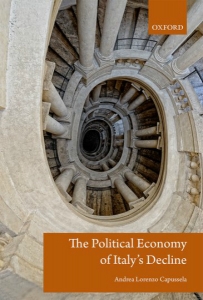In The Political Economy of Italy’s Decline, Andrea Lorenzo Capussela offers an account of Italy’s current political and economic malaise, charting the evolution of the current social order from the post-war years to the aftermath of the eurocrisis. This is an erudite and compelling study, writes Dominik A. Leusder, that will be a key theoretical resource for anyone seeking to better understand Italy’s present predicament.
The Political Economy of Italy’s Decline. Andrea Lorenzo Capussela. Oxford University Press. 2018.
The decline of democratic capitalism in Italy is perhaps the most consequential development in Europe today. While the symptoms of this decline – political dysfunction, low growth, high unemployment, wage stagnation, inequality, declining productivity – are becoming distressingly commonplace, Italy’s malaise is at once more severe and longer in the making. Despite boasting a sophisticated manufacturing sector and a sizeable current account surplus, Italy experienced the worst average per capita growth rate in the world between 2001 and 2010, the longest eurozone recession and the weakest recovery. Something else is clearly at work.
Andrea Lorenzo Capussela’s The Political Economy of Italy’s Decline is an erudite and compelling attempt to explain these developments. As former head of the economics unit at Kosovo’s International Civilian Office as well as one of the EU advisers to Moldova’s economy minister, Capussela is well-acquainted with the institutional and political determinants of economic growth, and is thus able to view Italy from an acute angle.
One of the merits of this book is the long-term view it takes of the decline, charting the evolution of the current social order from the post-war years to the aftermath of the euro-crisis. It does so through the lens of a collective action problem that is at the heart of the main argument (Chapter Four). Italy is trapped in a ruinous politico-economic equilibrium, maintained by deeply inefficient institutions, recalcitrant to political reform while crowding out public-spiritedness and innovation. This argument is premised on a composite understanding of institutions as both formal and informal (what Douglass North termed ‘the rules of the game in a society’), and how these institutions shape the expectations and structure the incentives of firms and individuals – with real macroeconomic consequences.
Two main questions are addressed: why did these institutional constraints on growth become more binding in the 1980s, and why has the equilibrium been so resistant to meaningful reform? Key to answering the first question is what Alexander Gershenkron referred to as ‘the advantage of backwardness’. In the immediate aftermath of the war, Italy’s relative agrarian backwardness proved advantageous: it led to the nation’s rapid convergence on the frontier of industrial economies. By the late 1970s, national income had nearly trebled while the rate of total factor productivity growth (TFP) had outstripped even Germany. The subsequent decades, however, saw Italy’s advantage rapidly decline. The large stock of sovereign debt accumulated by successive governments in the 1980s was in no small part the result of the need to offset the collapse in TFP growth.
In view of the numerous reform efforts throughout the same period, most commentators have been quick to dismiss institutional accounts of the decline, regarding as implausible the inverse relationship between growth and the quality of institutions. After all, how could Italy’s exemplary growth give way to sclerosis despite reforms? This apparent paradox has lent credibility to the widely held belief that the euro is chiefly to blame, eliminating as it does the possibility of devaluation while imposing fiscal constraints. While these arguments are not entirely without merit, they still fail to explain the severity and persistence of the symptoms relative to those of other countries in the eurozone ‘periphery’. Instead, Capussela suggests that the same institutions that lent themselves to the technological diffusion at the basis of rapid catch-up growth proved incapable of sustaining intensive, innovation-led growth. That is the reason why Italy’s institutional constraints only become binding at the eclipse of the Bretton Woods regime.

Image Credit: Palazzo della Banca d’Italia, Milan (Fred Romero CC BY 2.0)
Having done away with this confusion, Capussela sets out to identify two primary, interrelated mechanisms responsible for eroding growth. Perhaps the most consequential downward spiral exists in the public sector. It centres around the provision of pubic goods and is based on a simplified interaction between citizens, the government and the state. The model is based on two exchanges, with both set of actors acting under a budget constraint. Citizens pay taxes for the provision of goods services – distributed either in a fair and equal manner (public services) or through selective, particularistic means (private services) – while their political support is a function of the value of public services provided equivalent to the amounts of taxes they pay. This equivalence is broken when, by some exogenous shock, part of the budget is absorbed, and the value of public services is diminished relative to the tax burden. Citizens can then either choose to remain public-spirited or to resort to private measures by evading taxes and/or bribing politicians for private goods and services. Similarly, politicians can either risk their political survival by advocating potentially unpopular reforms or by accepting bribes in return for ‘selective inclusion’ (mainly welfare and regulatory policies). The predominance of opportunistic behaviour among risk-adverse politicians lowers the incentives for public-spirited behaviour among tax-paying citizens, which in turn constrains the government’s budget for the provision of public goods.
Institutions also govern the factor and product markets and shape the incentives to invest and innovate. Capussela locates another vicious circle in the relationship between corporate governance and misallocation. Italian firms are frequently both owned and managed by families, which, as the majority or controlling shareholder, predate on the minority shareholder in some way or another. Since minority shareholders will ask to be insured against the risk of predation, the price of equity is marked up, resulting in an increased reliance on debt-financing, which is less conducive to innovation.
This dynamic also raises the incentives for falsifying accounts, evading taxes, paying bribes for procurement and arbitrary subsidies or colluding with authorities for anti-competitive regulation. Here the mechanism interacts with the public sector vicious circle since it relies on the prevalence of political corruption. As a result, Italian firms remain comparatively small, grow less, allocate fewer resources to basic research and compete more on price than on innovation. The prevalence of predation gradually displaces more socially desirable routes to profits as rent-seeking becomes the dominant strategy for small and mid-sized firms. Once again, the diminishing returns of public-spirited behaviour result in opportunistic behaviour becoming individually rational. By the 1990s, these vicious circles had resulted in Italy losing its ‘social capacity’ for growth.
Capussela’s account may be read as a rebuke to those who have reached too readily for cultural stereotypes and high-minded policy platitudes that dominate commentary on Italy’s malaise. The book should be flung at overzealous economists who have been hailing tough supply-side reforms as the magic bullet for Italy’s problems. Apart from challenging the idea of the euro as the lone culprit, it also takes issue with the widely-entertained hypothesis that certain cultural attributes have an independent causal effect on the efficiency of the country’s institutions. Rather, it is the quality of the government and the character of institutions and public policy that result in a culture of ‘amoral familism’, opportunism and distrust. Put simply, it is Italy’s social order that undermines collective action.
Any efficiency-enhancing reforms that would discourage or sanction rent-seeking behaviour are likely to be undermined by the logic of the extant equilibrium, given how the very institutions that shape people’s incentives – trust in public institutions, social norm, civicness – remain firmly aligned with that same equilibrium. Such reforms ‘face the same collective action problem they seek to overcome’ (222). The basic social dilemma underlying these developments is the assurance game: citizens’ dominant strategies depend on credible expectations of whether others will act opportunistically or in a public-spirited manner. If we assume that Italian society is driven by this logic, then only a credible shift in citizens’ expectations can lower the threshold at which they are willing to act in a public-spirited way.
What could bring about such a shift? Capussela contends that ideas are the only credible catalyst for sustainable reforms since they are the only causal factors relatively independent of the downward spiral. In placing his bets on ideas, Capussela is in good company. The relationship between ideas and collective action that he suggests finds support in recent, more formal work by Dani Rodrik and Sharun Mukand, who demonstrate how ideas shape individual’s perceptions of their long-term interests. If it is indeed true that ‘today’s ideas become tomorrow interests’, then persuasive ideas might make citizens prefer what Albert Hirschman referred to as ‘voice’ over ‘exit’ and ‘loyalty’. Expectations that public-spirited behaviour will become rational will only be realistic, however, if persuasive ideas are made part of a credible political platform and are driven by a well-organised campaign. It is not clear that the incumbent government is advancing such a programme. Whatever the merits of expansionary fiscal policy, the recently approved plan to lower the age of retirement is at odds with the imperative to dismantle the ‘system of selective inclusion’.
Capussela assumes that the reassessment of individual interests resulting from such a campaign can be sufficiently widespread to weaken resistance to reforms. But the failure of the ambitious reform efforts of 1962 to 1964 (which faced concerted elite resistance and political violence) and the thwarted efforts that followed the mani pulite investigations of the early 1990s (which were cut short by the election of Silvio Berlusconi in 1994) are somber testimony to the resilience of Italy’s social order and the remote contingency that any exogenous shock can be successful in permanently shifting it.
The notion of a ‘battle of ideas’ as the most promising scenario in which the tensions between individual rationality and collective action that enfeeble Italy’s political economy might be resolved will not endear the author to any reader hoping to find straightforward policy prescriptions. One can’t help being reminded of how the social theorists of the Frankfurt School came to view their work: namely as a ‘message in a bottle’ sent as ‘the surviving message of despair from the shipwrecked’, addressed to an uncertain future.
At no point does Capussela suggest, however, that his interpretation is complete. Rather, he attempts to identify the deep-rooted institutional causes of Italy’s economic decline, the shortcomings of existing explanations as well as the type of change most likely to invert a vicious circle into a virtuous one. This attempt is highly persuasive. It provides a key theoretical resource for anyone wanting to make sense of the country’s current predicament which, in the absence of meaningful change, will persist ‘for as long as its material and moral consequences will be tolerable’ (222). It is not obvious, however, that Italian capitalism can survive long enough for any messages in bottles to arrive at its shores.
Please read our comments policy before commenting.
Note: This article is provided by our sister site, LSE Review of Books. It gives the views of the author, not the position of EUROPP – European Politics and Policy or the London School of Economics.
_________________________________
About the author
Dominik A. Leusder
Dominik A. Leusder is a political economist based in London. He is a graduate of the European Institute at the London School of Economics and Political Science. His research focuses on macroeconomic policy and growth in the eurozone. He tweets at @DominikLeusder


 Find this book:
Find this book: 

